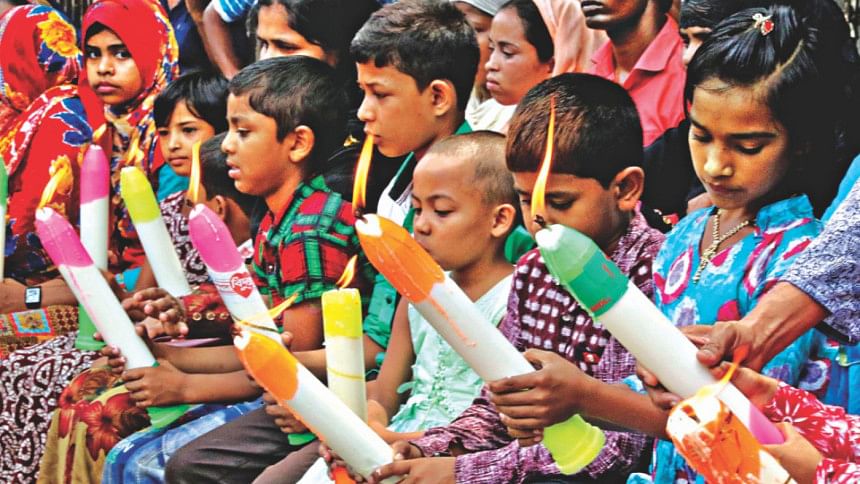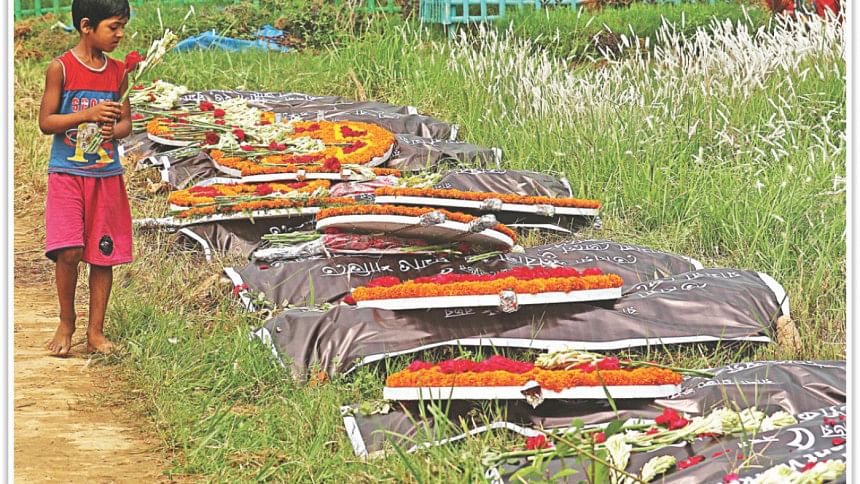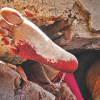When time fails to heal

Renuka Barai trod lightly on the edge of a hyacinth-filled lowland which once housed the ill-fated Rana Plaza factory complex. She stopped at the western side, a vacant look across her face.
A huge crowd had gathered around the place in front of a sculpture of a pair of hands holding a hammer and a sickle-- a symbol of proletarian unity. Fiery speeches were being hurled from loudspeakers.
But nothing distracted Renuka. She could not embrace the unity at the moment.
"This is the place where my son worked and died. It is where I lost everything," said the 45-year-old mother, her eyes brimmed with tears.
Her son Titu Barai, 29, was on his shift in one of the garment factories housed in the building when it collapsed in the morning of April 24, 2013, leaving at least 1,138 people dead. It was one of the world's deadliest industrial disasters.
Like Renuka, other family members and relatives of Rana Plaza victims, with photographs of their loved ones, thronged the site and shed tears as the nation observed the fifth anniversary of the disaster yesterday.
Amid the tears, a few shared their agonies at the site where their loved ones once toiled day and night stitching clothes for global brands in garment factories on the upper floors of the shoddily constructed nine-storey building.
Different trade union leaders and activists also paid tribute to the victims by placing wreaths at foot of the sculpture. They demanded justice for the “killing” and “sufficient compensation” for the victims.
Over the last five years, the country's RMG sector, which accounts for 80 percent of the country's exports, saw major changes in workers' safety methods as the collapse prompted the government and foreign buyers to do more to ensure labour rights and workplace safety.
But for victims like Renuka, it was all a little too late.

With an intellectually disabled husband to support, Renuka, a resident of Rajashan in Savar, toiled all her life to raise her three children. She used to stitch clothes at her home to fund their education. Her son, Titu, studied up to higher secondary before joining her mother's trade in 2005.
In December 2012, he started working in Phantom Apparel Limited, a garments factory in Rana Plaza.
"Our good days just started when my son got the job. But who knew his life would come to such an abrupt end here," said Renuka, who now lives with her daughter's family. Her youngest son lives separately.
After her Titu's death, she got more than Tk 16 lakh in compensation. With the money, she bought a piece of land in Rajashan and built a small house there.
"I faced many hardships but did not use the money for any other cause as it came at the cost of my son's life. This land is my son's memory," she said.
Asked what she wanted now, she said, “What I will seek? The loss can never be recouped. Whom I will hold responsible? The person responsible is yet to be tried.”
Elsewhere, Safia Begum was going through a twin tragedy. After her son Lal Mia was killed in the collapse, her husband died around one and a half years ago and her six other children live away from her.
“My son had not called me for the last five years,” she said looking at a photograph of his which she carried. It was perhaps all she had to remember him by.
“I want justice,” said the mother who earned her livelihood by selling cakes in front of the house she'd built with the money she received as compensation.

Halima Begum, a survivor of the collapse, did live but at the cost of an injury that will never let her forget the day -- April 24, 2013.
The horrifying memories of the building collapse still haunt her.
“It is not possible to forget the day. It has changed my life forever,” Halima said.
Like Halima, many survivors are still struggling to rebuild their lives as they were not given the financial support as they were promised. Many received financial assistance from the government, NGOs, charities and social organisations, which turned out to be inadequate to run the families.
“I got only Tk 28,000 in compensation. I could not work with my ailing body. It is very difficult for my lone son to bear the expense of our four-member family,” Halima said.
“My grandchild could not sit for his exams as we could not provide her tuition fee yesterday [Monday],” she said adding that she could not take treatment for want of money.
FRUSTRATION OVER DELAYS
As the victims and their family members were expressing their agonies and miseries, many paid their tribute by placing floral wreaths at the base of the monument at the site of the tragedy. Different organisations brought out processions and held rallies there demanding justice for the Rana Plaza victims.
“Five years have gone by and we still see no progress in ensuring justice,” Jolly Talukder, general secretary of Garments Workers' Trade Union Centre, said. “We demand quick trial of all the people involved with the Rana Plaza disaster.”
Eminent rights activist Sultana Kamal said this was no accident; rather it was murder, caused by the negligence of the people responsible for the workers' security.
“This is not a secret murder. It took place in broad daylight before everyone. It should not have taken more than a year to complete the trial of the case.”
I am very frustrated and aggrieved as the case remained stuck for two years. I think it was not disposed of to save those who were responsible [for the tragedy],” said Sultana, also a former advisor to a caretaker government.
Holding “state negligence” as the reason behind the tragedy, eminent columnist Syed Abul Moksud demanded April 24 to be declared “Shaheed Shramik Dibash” to commemorate the victims and ensure safety in the workplace.
Gonoforum President Dr Kamal Hossain asked to learn from the incident to stop recurrence of such a tragedy.
Asked about the delay in trial, he said he would personally move the issue before the High Court.
TRIBUTE PAID AT JURAIN GRAVEYARD
Many families of victims, pro-labour organisations and common people went to Jurain graveyard where unidentified bodies from the disaster were buried. Later, some of the bodies were identified with DNA test but many remained unidentified.
Rubina was walking along one grave to the other searching for any clue as to which might be her cousin Rozina's grave.
Failing to find it, she stood in solemn silence for a while.
“I was working in Dubai when the Rana Plaza collapsed. I came home two months ago. Now I have come to search for my cousin. But, I don't know where she is,” Rubina told The Daily Star.
Five years after the Rana Plaza collapse, it would be difficult to find a particular grave as there were no identification marks.
Children of some schools near the grave also came to pay their respect and place flowers.
Our Savar correspondent contributed to this article.

 For all latest news, follow The Daily Star's Google News channel.
For all latest news, follow The Daily Star's Google News channel. 








Comments